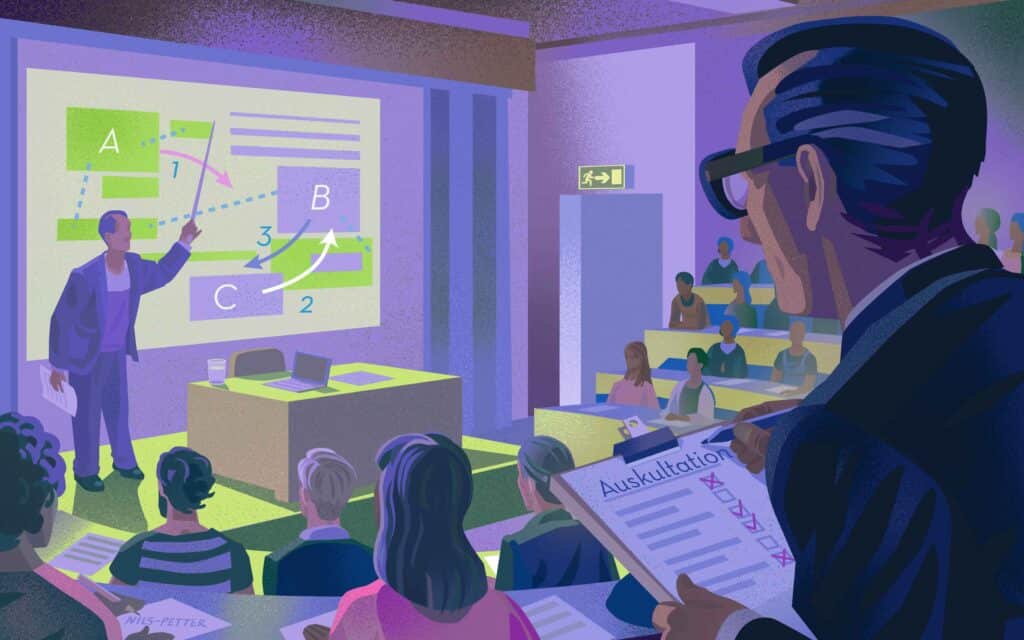Peer review is an essential part of the work of a researcher and a vital source of development, but in their role as a teacher, that same person is often left alone to work with their methods and material. Breaking that isolation is one of many reasons for working with observation of each other’s teaching.
That is the view of senior lecturer Jeanna Wennerberg and her colleagues, whose project has resulted in a number of research articles and their method of teaching observation being sought after by others.
“The participating teachers have grown in their teaching role, felt less isolated and acquired new ideas about teaching,” says Wennerberg. “Observation has also led to spin-off effects such as team-teaching and more collegial discussion about teaching.”
Before she and her two colleagues launched the project in their teaching team at the Department of Swedish and Multilingualism at Stockholm University in 2019, they had observed each other’s lessons several times. And this framed Jeanna Wennerberg’s picture of how observations usually go: colleagues who are already friends observe each other on their own initiative, but many teachers do not have the same opportunities and the knowledge and learning is restricted to a small number of colleagues.
So when the teachers at their own department expressed a desire to collaborate more, they developed a more structured method for teacher observation within the teaching team.
A key aspect of the model is that the teacher who is being observed must specify in advance what they want to receive feedback on. The person who observes should not give unsolicited criticism in other areas, but can of course use their other reflections for their own learning and development.
“There is a psychological reason for agreeing on what the feedback should focus on.”
Jeanna Wennerberg
“There is a psychological reason for agreeing on what the feedback should focus on,” says Wennerberg. “It can make it less intimidating to invite a colleague to observe your teaching, as well as make it easier for the colleague to offer constructive criticism afterwards.”
Another important part of the model is that the observer uses a template with supporting headings based on the feedback the teacher wants, for example ”Teacher as speaker”, ”Teaching content”, ”Student learning”, ”Requested response” or ”Open response”.
The participants started with a meeting where they agreed on a method and structure for the teaching observations and adjusted the proposed templates. This made it easier to then ask to observe a colleague, regardless of relationships or hierarchies.
Before each teaching observation, the two people involved met to go over the content of the course and the desired outcome. Immediately after the observation session, they had a feedback meeting, also with a template to support them.
“But you cannot predict everything you will learn when you observe someone teaching,” Wennerberg explains. “You may discover that the teacher asks excellent control questions or has a great attitude towards and interaction with the students. At the same time, it is beneficial to see that your colleagues are not always superteachers.”
After a number of teaching observations had been carried out, five or six teachers got together every few weeks with a dialogue leader to discuss how the teaching observations had gone, as well as their reflections and ideas regarding the teaching from an operational perspective. “It might be that they find the progression in different courses is different or there is a need for better digital support.”
Since the project ended, teaching observations and collegial meetings about teaching have continued under their own steam.
“It has become part of the way we work in the teaching team, an open-door policy,” says Wennerberg.
During the term in which the project took place, the teachers had time dedicated to it: three hours per teaching observation. It turned out to be time well spent to raise the quality of teaching and increase motivation within the department. The research articles on the teaching observation project and the method’s instructions and templates are also openly available at su.figshare.com.
“A model like this could be developed into a collegial higher education teaching course run by the institution and which gives higher education credits or a diploma as an academic qualification,” Wennerberg suggests.
Independently of the colleagues at Stockholm University, the Department of Language, Literature and Learning at Dalarna University started a teaching observation project in the spring of 2023.
They also started and ended the term with meetings together with the participating teaching staff. However, they did not use templates or specific requests regarding feedback for the observations.
“But the feedback must of course be given in a respectful way and be based on mutual trust,” says Céline Rocher Hahlin, who is a senior lecturer in French and was one of the participants in the project.
In principle, all language courses at the university are web-based, which means that the observations could also cover more technical matters.
“Teaching online requires a very clear structure, and a clear body language to create a sense of community, so that can also be interesting to observe,” says Rocher Hahlin.
“Teaching online requires a very clear structure, and a clear body language to create a sense of community.”
Rocher Hahlin
The person who observed the lesson chose whether to sit with the teacher to see how they worked behind the screen or to observe online.
“For example, I wanted to be among the students and be divided into break-out rooms to observe the dynamics that I otherwise cannot see in the same way as a teacher,” she explains.
She describes the final meeting with the entire teaching team as incredibly rewarding, but also difficult to fit into her normal busy schedule. The lesson observations have therefore continued, but without full teaching department meetings at the beginning and end of the term.
Instead, the department now only has a web-based document where teachers can easily fill in what courses they have and whether they would like to observe or be observed by colleagues. Then those who are interested make contact and arrange teaching observations themselves.
“It has opened many doors, so the next time I want to test an idea, it feels natural to discuss it with my colleagues. It is a luxury to have a colleague watch you teach and it really benefits the department and the university.”
Five tips for successful teaching observation
- It is important that observation is voluntary, and it is sufficient that a few people want to start.
- Agree on how you will conduct the observations. A clear structure can help.
- Position yourself so that you do not disturb the lesson.
- Give feedback as soon as you can after the observation session.
- Complement with collegial discussions about the teaching in larger groups.


















